Bennemann K.H., Ketterson J.B. Superconductivity: Volume 1: Conventional and Unconventional Superconductors; Volume 2: Novel Superconductors
Подождите немного. Документ загружается.


13 Unconventional Superconductivity in Novel Materials 671
directional nature of the tunneling measurements
provides informationabout the symmetry of the su-
perconducting order parameter.Order parametersof
odd parity can be ruled out due to the strong Pauli
limitingthatis observedin UPd
2
Al
3
,andthereis only
one even d-wave point group that does not show a
gap node along the c-axis. The authors concluded
therefore that only the fully symmetric A
1g
d-wave
representation is consistent with the measurements.
Nuclear Magnetic Resonance
Two types of NMR and NQR measurements have
been performed on UPd
2
Al
3
:
27
Al measurements by
Kyogaku and coworkers in the early 1990s [219],and
more recently
105
Pd NMR measurements by Matsuda
et al. [206]. Both types of measurements agree as
to the nature of the superconductivity in UPd
2
Al
3
.
The spin-lattice relaxation rate T
1
derived from
105
Pd
NQR results is plotted as 1/T
1
vs temperature T in
Fig. 13.32. Between T
c
and T
N
,1/T
1
varies as T in
accordance with the Curie–Weiss law. Below T
c
,1/T
1
followsa T
3
temperature dependence,andthe Hebel–
Slichter peak usually seen in BCS superconductors
is absent. These data are consistent with the pres-
ence of unconventional superconductivity with an
anisotropic energy gap that has line nodes on the
Fermi surface.The best fit to the 1/T
1
vs T data gives
a superconducting energy gap of 2(0) = 5.5 k
B
T
c
.
This energy gap is larger than that measured by neu-
tron diffraction, perhaps due to anisotropy of the
energy gap.In contrast to the NMR and NQR results,
the T
3
temperature dependence of the specific heat
implies point nodes on the Fermi surface.Additional
NQR measurements at lower T are necessary to re-
solve this discrepancy. It is also possible that both
point and line nodes are present and only one domi-
nates in each measurement.
The magnetic properties of UPd
2
Al
3
can only
be discerned from
105
Pd NMR and not from
27
Al
NMR measurements. This is because the Al atoms
are located interstitially between Pd-U sheets, so
transferred hyperfine fields from neighboring anti-
aligned U moments are canceled almost perfectly,
and T
1
reflects only the susceptibility of the conduc-
tion electrons. On the other hand, the Pd atoms are
Fig. 13.32. Spin-lattice relaxation rate 1/T
1
of UPd
2
Al
3
as
a function of temperature T determined from
105
Pd NQR
measurements in the vicinity of the N´eel temperature T
N
andsuperconducting transition temperatureT
c
,after[206]
surrounded ferromagnetically by U moments, which
affect the Pd T
1
relaxation via the hyperfine inter-
action. The results of a recent
105
Pd NMR and NQR
study are described below.
105
Pd NQR measurements show [206] a resonance
line at ≈ 5 MHz which is split into two lines in the
AFM state.The splitting can be explained by the pres-
ence of a 2.9 kOe internal field. The temperature de-
pendence of this internal field, which extrapolates
to zero at T
N
, closely matches that of the sublat-
tice magnetization measured by neutron diffraction
measurements[183,209].The presence of a local field
throughout the sample below T
c
confirms the micro-
scopic coexistence of antiferromagnetism and un-
conventional superconductivity.
The hyperfine coupling constant, deduced from
the Knight shift, is very small (0.3kOe/
B
), indicat-
ing that there is no significant polarization density
of Pd 4d electrons.Furthermore,the large value of T
1
above T
N
confirms that the Pd ions are nonmagnetic
and only very weakly coupled to the U ions.
The NMR and NQR measurements of UPd
2
Al
3
confirm unconventional superconductivity with an
energy gap that goes to zero at lines on the Fermi sur-
face. The
105
Pd NMR and NQR measurements show
that the antiferromagnetism is due to U local mo-
ments with an internal field H =2.9kOe.Further-
more,the results unambiguously demonstrate the co-
existence of antiferromagnetism and superconduc-
tivity.
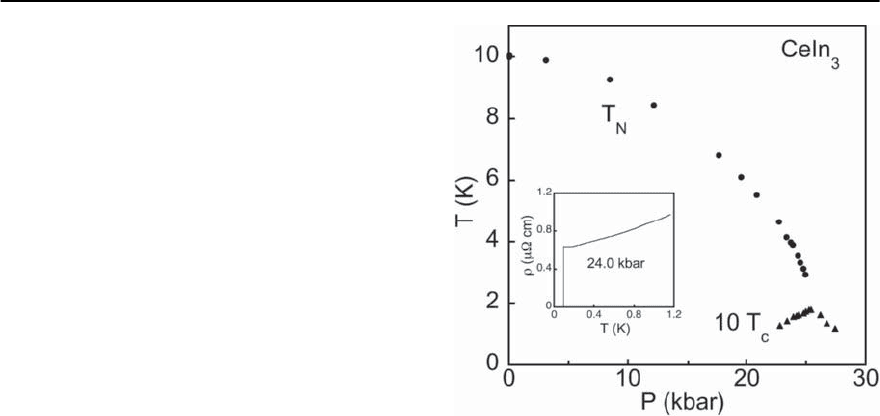
672 M.B. Maple et al.
13.3.5 Quantum Critical Points
Introduction
Quantum phase transitions (QPT) are observed in
many f -electron heavy-fermion systems,in which an
antiferromagnetic or ferromagnetic transition tem-
perature, spin glass freezing temperature, or spin
density wave (SDW) is suppressed to T =0Kby
pressure or chemical substitution.When the QPT is
a second-order phase transition, it is referred to as
a quantum critical point (QCP). A wide variety of
f -electron materials display QPTs or QCPs including
CeIn
3
andCePd
2
Si
2
(AFM),UGe
2
(FM),and CeCu
2
Si
2
(SDW).In the vicinityof the criticalpressure or con-
centration ı
C
at which the QCP occurs, so-called
non-Fermi-liquid (NFL) behavior is often observed;
itmanifestsasunusualpower-lawtemperaturede-
pendencies of the physical properties at low temper-
atures. NFL behavior is discussed in more detail in
Sect. 13.3.6. In some compounds, superconductivity
also occurs in a narrow region around the critical
pressure P
c
at the QCP. The presence of supercon-
ductivity in the vicinity of the QCP suggests that the
superconducting electron pairing mechanism may
be mediated by magnetic fluctuations. QCPs are also
observed in the high-T
c
cuprate superconductors as
discussed in Sect. 13.5.
CePd
2
Si
2
and CeIn
3
Lonzarich and coworkers [1, 2] reported measure-
ments of the temperature dependence of the electri-
cal resistivity of single crystal specimens of the AFM
compounds CeIn
3
and CePd
2
Si
2
at various pressures
up to ∼ 30 kbar. The N´eel temperature T
N
, deter-
mined from a discontinuity in the slope d/dT at
T
N
, was found to decrease monotonically with in-
creasing P for both compounds and to extrapolate to
zero at a critical pressure P
c
of ≈ 26 kbar for CeIn
3
and ≈ 28 kbar for CePd
2
Si
2
. At temperatures below
1 K and pressures in a narrow region near P
c
, (T)
was found to drop abruptly, indicative of supercon-
ductivity for both compounds.The dependence of T
c
on P has an inverted parabolic shape,reminiscent of
the shape of the T
c
vs charge carrier concentration
curvefoundforthehighT
c
cuprate superconductors.
Fig. 13.33. Temperature-pressure T − P phase diagram of
CeIn
3
showing theN´eel temperature T
N
and superconduct-
ing transition temperature T
c
(plotted as 10T
c
)Theinset
shows the superconducting transition in the resistivity
vs temperature T at P =24kbar,after[1].
The N´eel temperature and superconducting transi-
tion temperature are plotted vs pressure in Fig. 13.33
for CeIn
3
. The inset to this figure shows the super-
conducting transition in (T)at24kbar.AtP = P
,
the pressure at which the maximum in T
c
occurs,
the superconductivity and AFM appear to coexist.
However, at pressures above P
, T
N
can no longer be
defined from the electrical resistivity measurements.
The transition from the AFM to the paramagnetic
state appears to become first order or to be broad-
ened in temperature due to pressure inhomogeneity
such that it can no longer be detected in (T)mea-
surements.
The observation of superconductivity near P
c
,
the pressure at which T
N
extrapolates to zero, sug-
gests that AFM spin fluctuations may be responsi-
ble for the pairing of superconducting electrons in
these two compounds. Spin-fluctuation theories pre-
dict [220–223] that the resistivity in the vicinity of
the QCP should vary as T
n
with n =3/2for3DAFM
fluctuations and n = 1 for 2D AFM fluctuations (Ta-
ble 13.5). In CeIn
3
and CePd
2
Si
2
, it was observed that
near P
c
and above T
c
, (T)variesasT
n
with n =1.6
for CeIn
3
and n =1.2 for CePd
2
Si
2
. These results

13 Unconventional Superconductivity in Novel Materials 673
suggest that the spin fluctuations have 3D charac-
ter in cubic CeIn
3
and 2D character in tetragonal
CePd
2
Si
2
. Spin-fluctuation theory also predicts that
the magnetic ordering temperature near P
c
should
vary as (P
c
− P)
y
where y =2/3 for 3D and 1 for 2D
fluctuations.While a linear dependence of T
N
on P
c
was observed in CePd
2
Si
2
, consistent with 2D fluc-
tuations,a power-law has not yet been distinguished
for CeIn
3
.
CeMIn
5
(M = Co, Ir, Rh)
The CeMIn
5
(M = Co,Rh,Ir)family ofheavy-fermion
compounds was discovered only a few years ago, yet
has attracted an enormous amount of attention and
display a variety of interesting phenomena including
unconventional superconductivity, possible Ferrel–
Larkin Fulde–Ovchinnikov (FFLO) superconductiv-
ity,antiferromagnetism,quantum critical points,and
non-Fermi liquid behavior [115–117, 152, 178, 224,
225]. CeRhIn
5
displays AFM order at T
N
=3.8K,but
becomes superconducting under pressure with a T
c
of about2.2 K at 21 kbar [115].CeIrIn
5
is a supercon-
ductor at ambient pressure with a bulk T
c
=0.4K,
but a resistive superconducting transition at a higher
temperature of T
c
=1.2 K [116].Finally,CeCoIn
5
be-
comes superconducting at 2.3 K, which is the high-
est T
c
of any Ce-based heavy-fermion superconduc-
tor yet discovered [117]. Measurements of power-
law T-dependencies in the specific heat [116,117],
NMR relaxation rate [226, 227], and thermal con-
ductivity [228] show that CeCoIn
5
and CeIrIn
5
are
unconventional superconductorswith nodal gaps.In
particular, Izawa and coworkers measured [229] the
directional thermal conductivity of CeCoIn
5
single
crystals in an external magnetic field rotated in the
ab plane.The thermal conductivity data show a four-
fold symmetry with peaks (corresponding to a nodal
direction) when the magnetic field is aligned in the
[110] direction.These data are consistent with d
x
2
−y
2
symmetry of the superconducting energy gap.
Before discussing quantum critical points in the
CeMIn
5
(M = Co, Rh, Ir) systems, a description
of the unusual nature of the superconductivity in
CeCoIn
5
will be presented. Recent measurements
[197,229–232] of specific heat, magnetization, ther-
mal conductivity, and thermal expansion show that
the superconducting transition of CeCoIn
5
becomes
first-order for applied magnetic fields above 47 kOe
in the [001] direction, and 100 kOe in the [100]
direction. Evidence for the first order transition is
also found in quasi-adiabatic magnetic field sweeps
where the temperature of a thermally isolated sam-
ple is measured as a function of applied magnetic
field [230]. For fields in the [001] direction, the tem-
perature vs field data show a kink at temperatures
above 0.72 K, corresponding to a second-order tran-
sition, and a step at temperatures below 0.72 K, cor-
responding to the latent heat released by a first-order
transition.
First-order superconducting transitions were pre-
dicted in 1964 by Maki and Tsuneto [19,233] for su-
perconductors in the clean limit where spin-orbit
scattering can be neglected. However, CeCoIn
5
is
the first superconductor to date to unambiguously
demonstrate a first-order transition in specific heat
measurements. The application of a magnetic field
to a spin-singlet superconductor can destroy the su-
perconductivity via two effects: orbital pair break-
ing, in which the field-induced kinetic energy of
the Cooper pair exceeds the superconducting con-
densate energy, and Pauli paramagnetic limiting, in
which it is energetically favorable for the electron
spins to align with the magnetic field, thus break-
ing the Cooper pairs (see Sect. 13.2.). The critical
field determined by orbital pair breaking is given
by Eq. (13.22), whereas the critical field from Pauli
paramagnetic limiting is H
p
=
0
/
√
2
B
.TheMaki
parameter ˛ =
√
2H
c2
(0)/H
p
is a measure of the rel-
ative strengths of these two effects.When Pauli para-
magnetism is dominant and ˛ ≥ 1.8, the super-
conducting transition is predicted to become first
order at temperatures below a reduced temperature
t
0
= T
0
/T
c
[234]. Several groups have calculated the
Maki parameter for CeCoIn
5
[230,235,236] with re-
sults ranging from 3.2 to 13. While there are vary-
ing techniques and experimentaldifficulties in deter-
mining the precise value of ˛,allthemeasurements
agree that ˛ > 1.8 indicating that CeCoIn
5
is para-
magnetically limited. Furthermore, thermal conduc-
tivity measurements indicate that CeCoIn
5
is in the
clean limit with l/
0
= 14 [228].
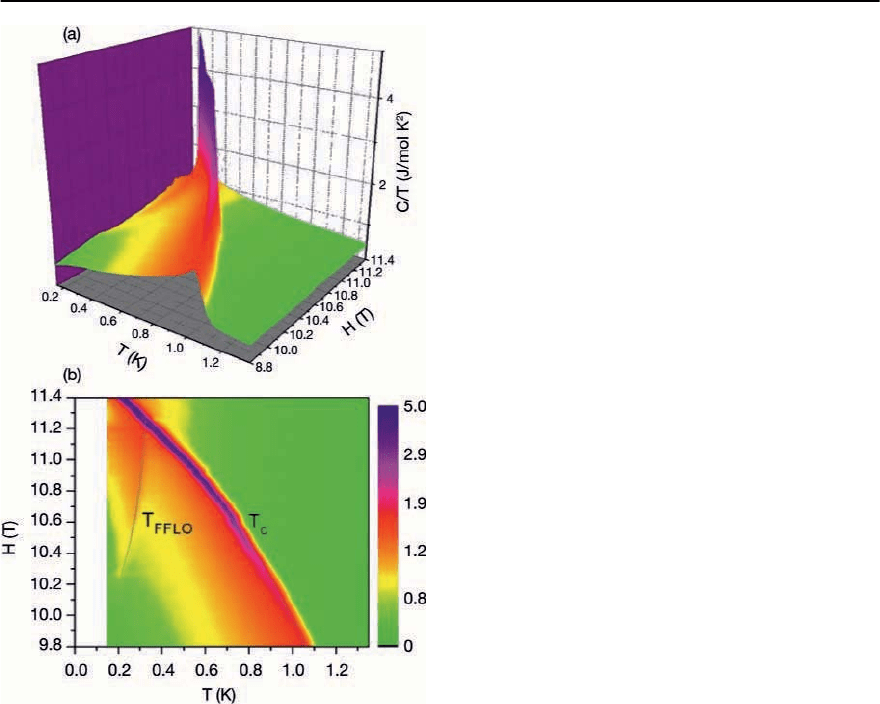
674 M.B. Maple et al.
Fig. 13.34. (a) Electronic specific heat of CeCoIn
5
plotted
as C/T vs temperature T and field H for H || [110]. (b)
Contour plot of the data in (a) with the same color scale.
Plots are from Bianchi et al. [232]
Recent measurements on CeCoIn
5
have revealed
that when T
c
is suppressed below 0.3 K by magnetic
fields, another transition occurs below T
c
that is
second-order. This transition has been observed in
specific heat vs magnetic field [235], specific heat vs
temperature [232], thermal conductivity [237], and
in penetration-depth measurements using a self-
resonant tank circuit [236]. This second transition
is most prominent for H in the ab plane; however,
Bianchi et al. also observe a small effect for H along
the crystallographic c-axis. The shape of the phase
diagram is strongly suggestive of an “FFLO” state
occurring between the second and the first-order
transitions. In this state, which was independently
predicted by Fulde and Ferrell [238] and Larkin and
Ovchinnikov [239] in 1964, the superconductor low-
ers its energy in a magnetic field by forming periodic
regions of superconductivity separated by domains
of aligned spins. The order parameter is spatially
modulated and changes sign, either sinusoidally or
more abruptly. The FFLO state is predicted to occur
at high fields, and at temperatures T
FFLO
< T < T
c
in samples which are in the clean limit and for which
spin-orbit scattering can be neglected. CeCoIn
5
is
an excellent candidate for an FFLO state. It is in
the clean limit with l/
0
∼ 14 [228], has a cylindri-
cal two-dimensional Fermi-surface [240,241] and a
d-wave superconducting order parameter. Specific
heat data as a function of temperature and magnetic
field by Bianchi et al. [232] exhibiting a first-order
superconducting transition and the possible FFLO
region is shown in Fig. 13.34. Further work such as
STM measurements or neutron-diffraction will be
necessary to settle the question of FFLO supercon-
ductivityin this system.The FFLO state has also been
suggested to occur in CeRu
2
and UPd
2
Al
3
; however,
in CeRu
2
the candidate FFLO transition was later
found to be associated with vortex flux-line melt-
ing [242–244], and in UPd
2
Al
3
, the transition was
not consistent with theory [245].
The unconventional superconducting state in
CeCoIn
5
appears to evolve out of an equally unusual
non-Fermi-liquid normal state.The resistivity above
T
c
varies linearly with temperature, and the specific
heat diverges logarithmically with temperature when
a magnetic field of 5 T (greater than H
c2
)isapplied
along the [001] direction. However, at higher mag-
netic fields and low temperatures, Fermi-liquid be-
havior is recovered in the specific heat and electrical
resistivity [117, 232,246]. The high field phase dia-
gram has been investigated by Paglione et al. [246]
and by Bianchi et al. [232]. The phase diagram by
Paglione et al. based on electrical resistivity and spe-
cific heat measurements is shown in Fig. 13.35. Fur-
thermore, Bianchi et al. find scaling of the Sommer-
feldcoefficient = C/T with(H−H
c
)/T over a broad
range of temperatures and fields both in the FL and
the NFL regime [232]. It is extremely unusual to find
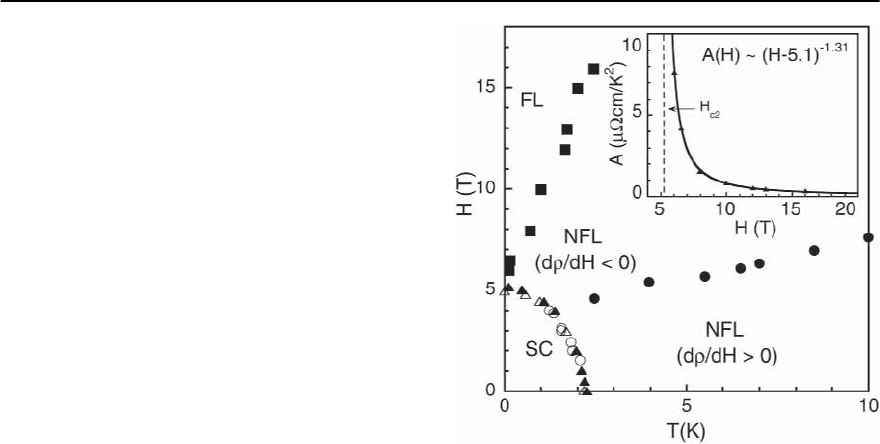
13 Unconventional Superconductivity in Novel Materials 675
a QCP associated with a superconducting transition,
and, in fact, the scaling behavior is indicative of a
second-order QCP whereas the superconductivity is
first-order near H
c2
.Both groups have therefore sug-
gested that the QCP responsible for the NFL is in fact
a second-order antiferromagnetic one, where the an-
tiferromagnetic order is prevented or“hidden”by the
superconductivity.
This question of whether the QCP is the direct
result of the destruction of superconductivity, or
only accidentally coincident with the upper critical
field in CeCoIn
5
has been probed by three stud-
ies that seek to tune H
c2
and watch the evolution
of the quantum critical behavior. If the supercon-
ductivity is ‘hiding’ an incipient antiferromagnetic
quantum critical point, then tuning H
c2
should ei-
ther reveal antiferromagnetism or drive the system
towards Fermi-liquid behavior. In one study, the
quantum critical behavior was investigated for both
H||c where H
c2
=4.95 T and H||ab where H
c2
=12T
[247]. In the second study [248], the suppression
of H
c2
and concomitant QCP behavior was stud-
ied in the series CeCoIn
5−x
Sn
x
. Both studies found
that the quantum critical behavior always occurred
at H
c2
, regardless of how H
c2
was varied. The non-
Fermi liquid behavior near the quantum critical
point was evidenced in the specific heat C(H, T)as
C
el
/T ∼ −lnT and scaling of the Sommerfeld co-
efficient [( (H)− (H
QCP
]/(H)
˛
∼ H/T
ˇ
where
˛ =0.7(1) and ˇ =2.5(5) for x = 0, 0.03, 0.06, with
˛ =0.9(1) and ˇ =3.0(5) for x =0.12. The elec-
trical resistivity shows non-Fermi liquid behavior in
the form of (T) ∼ T
˛
where ˛ =1.5. These two
experiments show that the quantum critical behav-
ior is directly related to the suppression of super-
conductivity, rather than being coincidental. In one
interpretation, the quantum fluctuations present at
low temperatures are responsible for both the su-
perconducting pairing mechanism as well as the
quantum critical behavior when the superconduc-
tivity is destroyed with magnetic fields. The third
recent set of experiments of electrical resistivity at
applied pressure and in magnetic field revealed that
the field for criticality H
QCP
was suppressed more
rapidly than the upper critical field H
c2
with applied
pressure [249]. This suggests that an antiferromag-
Fig. 13.35. Magnetic field H vs temperature T phase dia-
gram of CeCoIn
5
. Solid squares are the boundary between
Fermi-liquid (FL) behavior with (T)=
0
+AT
2
and non-
Fermi liquid (NFL) behavior. Solid circles indicate a max-
imum in magnetoresistivity,solid triangles are H
c2
deter-
mined from resistivity, and open triangles and open circles
are H
c2
from resistivity and specific heat data in [117]. The
inset shows the coefficient A in the FL regime as a function
of field, which diverges near the upper critical field H
c2
of
CeCoIn
5
, after [246]
netic quantum critical point is responsible for the
NFL behavior in CeCoIn
5
.
Another quantum critical point in CeCoIn
5
may
occur at negative pressures [225]. Evidence for this
comes from the fact that CeRhIn
5
is an antiferro-
magnet with a larger unit cell than CeCoIn
5
.TheN´eel
temperature of CeRhIn
5
can be suppressedwith pres-
sure leading to superconductivity above P =16kbar,
with a T
c
= 2 K, remarkably close to that of CeCoIn
5
.
At this pressure, the unit cell volume of CeRhIn
5
is also close to that of CeCoIn
5
. In fact, there is a
general correlation in the CeMIn
5
(M = Co, Rh, Ir)
compounds between the superconducting transition
temperature T
c
and the lattice parameters [250]. It
appears that, with the exception of the compounds
displaying antiferromagnetism, T
c
varies as a linear
function of the lattice anisotropy c/a where c and
a are the tetragonal lattice parameters. In Fig. 13.36,
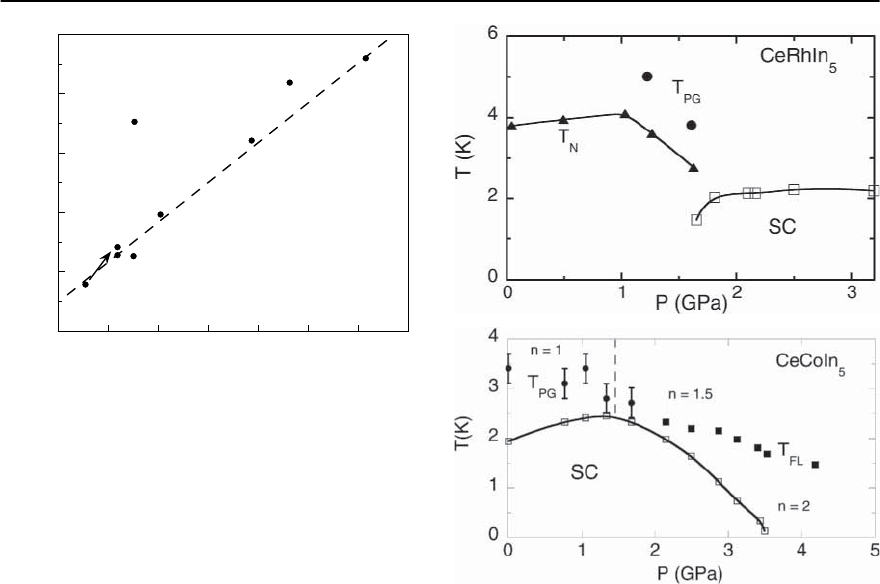
676 M.B. Maple et al.
0
0.5
1
1.5
2
2.5
1.605 1.610 1.615 1.620 1.625 1.630 1.635 1.640
T
c
)K(
lattice c/a
CeIrIn
5
CeCo
0.5
Ir
0.5
In
5
T
c1
CeRh
0.25
Ir
0.75
In
5
16 kbar
CeRh
0.5
Ir
0.5
In
5
CeCo
0.5
Ir
0.5
In
5
T
c2
CeCo
0.5
Rh
0.5
In
5
CeRhIn
5
(~ 16 kbar)
CeCoIn
5
Fig. 13.36. Superconducting transition temperature T
c
plot-
ted vs the ratio of the tetragonal lattice constants c/a for
various compounds in the CeMIn
5
family (M = Co, Rh, Ir),
after [250]
T
c
is shown as a function of c/a for members of the
CeMIn
5
family both under ambient pressure and hy-
drostatic pressures.
Thus, CeRhIn
5
could be considered equivalent to
CeCoIn
5
with an expanded lattice parameter,or“neg-
ative pressure”.When pressure is applied to CeCoIn
5
,
T
c
goes through a maximum at P =15kbarandis
suppressed by P ∼ 37 kbar. When the CeRhIn
5
and
CeCoIn
5
phase diagrams are combined, considering
CeCoIn
5
at ambient pressure equivalent to CeRhIn
5
at P = 16 kbar, the resulting phase diagram looks
remarkably similar to those of the high-T
c
cuprates
(Sect.13.5).In fact, several groups suggest the forma-
tion of a pseudogap near the QCP based on electrical
resistivity and
115
In NQR measurements [225,252].
The T − P phase diagrams of CeRhIn
5
and CeCoIn
5
are shown in Fig. 13.37. Fermi-liquidbehavior in the
resistivity with a T
2
temperature-dependence is re-
covered at higher pressures, as shown.
The details of the pressure-induced quantum crit-
ical point in CeRhIn
5
have been extensively studied
in an effort to understand the quantum criticalpoint
and the attendant superconductivity [151,252–257].
Pressure studies in zero applied magnetic field using
specific heat, resistivity, NMR, and neutron scatter-
ing indicate that the line of antiferromagnetic tran-
Fig. 13.37. Upper figure: Temperature-pressure T − P phase
diagrams of CeRhIn
5
from electrical resistivity and ac sus-
ceptibility measurements (after [251]). Lower figure: T − P
phase diagram of CeCoIn
5
based on electrical resistivity
(after [225])
sitions T
N
(P) vanishes abruptly at the top of the su-
perconducting dome at P
c1
.Some of the studies show
that superconductivity and antiferromagnetism co-
exist for P < P
c1
with T
N
> T
c
. Recent de Haas-van
Alphen measurements [258] reveal a divergence of
the effective mass at P
c2
∼ 25 kbar indicating an
AFM QCP at that pressure. The dHvA frequencies
change dramatically from a “small” Fermi surface,
where the 4f electrons of Ce are only weakly hy-
bridized with the conduction electrons, to a “large”
Fermi surface in which there is strong hybridization.
This has been interpreted as a localized/itinerant
crossover of the f electrons at the QCP. It is inter-
esting to note that the dHvA frequencies above P
c2
in
CeRhIn
5
closely resemble those of CeCoIn
5
at ambi-
ent pressure[259] indicating that CeCoIn
5
isthe itin-
erant version of localized CeRhIn
5
.A recent study of
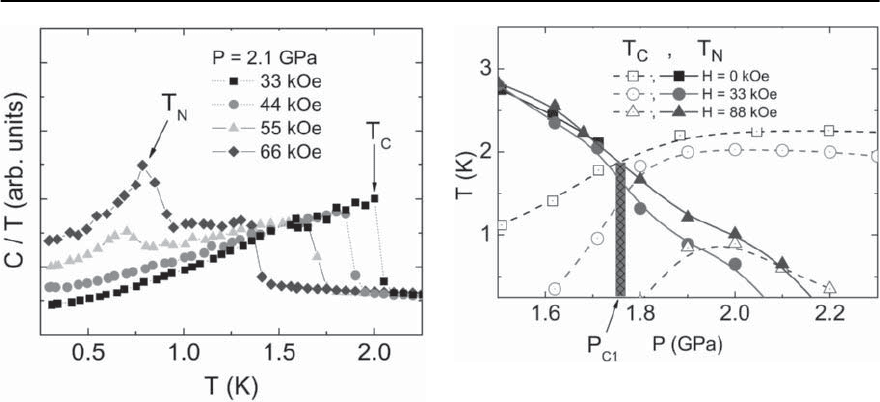
13 Unconventional Superconductivity in Novel Materials 677
Fig. 13.38. ac calorimetry data for CeRhIn
5
in applied hy-
drostatic pressures of 2.1 GPa for various applied mag-
netic fields. Superconducting critical temperature T
c
and
the onset of antiferromagnetic order T
N
are indicated (af-
ter [260])
CeRhIn
5
in magnetic fields under pressure using ac
calorimetry shows that application of magnetic field
allows the line of quantum phase transitions T
N
(P)
to extend into the superconducting dome such that
AFM and SC coexist with T
c
> T
N
[260]. The ac-
calorimetry data is shown in Fig.13.38 and the T − P
phasediagramforvariousmagneticfieldsisshown
in Fig. 13.39.
An interesting question is what happens
when CeRhIn
5
and CeCoIn
5
are mixed to form
CeRh
1−x
Co
x
In
5
, and whether tuning the lattice pa-
rameters via concentration is equivalent to tuning
the lattice parameters with pressure. Substitution
studies of both CeRh
1−x
Ir
x
In
5
and CeRh
1−x
Co
x
In
5
systems have been carried out and the phase dia-
grams are shown in Fig. 13.40 [191, 261]. Both sys-
tems show a strikingly similar suppression of the
N´eel temperature T
N
with increasing x,withT
N
ex-
trapolating to zero at a QCP at x ∼ 0.6−0.8(see
Fig. 13.37). The fact that T
N
depends only on the
Rh concentration in these two systems, and not on
the lattice parameters, strongly suggests a percola-
tionproblem.AntiferromagnetismisdestroyedasRh
atoms are removed from the system.This percolation
is nontrivial however,since the magnetic moment re-
Fig. 13.39. Temperature-pressure phase diagram of
CeRhIn
5
for various magnetic fields. In applied fields,
the antiferromagnetism extends into the superconducting
dome, allowing antiferromagnetism and superconductiv-
ity to coexist with T
N
< T
c
.Thequantumcriticalpoint
P
c1
above which antiferromagnetism vanishes for H =0is
indicated (after [260])
sides on the Ce atom and not on the Rh atom. SR
measurements [262] show that a small ordered mo-
ment may reside on the Rh atom; however, a final
understanding of the role of the Rh atom in creating
a three-dimensional Fermi surface and long-range
AFM order in these systems is still lacking. Thus, the
phase diagrams of the substituted systems are pro-
foundly different that those of CeRhIn
5
and CeCoIn
5
under pressure (see Fig. 13.37). The superconduc-
tivity coexists with antiferromagnetism over a very
broad range of concentrationsand does not show the
dome-shape typical of quantum critical points.
For the CeRh
1−x
Co
x
In
5
system, the specific heat
plotted as C/T vs T for various Co concentrations x
is shown in Fig. 13.41 [191].(These data arevery sim-
ilar to those of the CeRh
1−x
Ir
x
In
5
system in [261].)
Each specific heat curve contains either one or two
peaks. The peaks for T < 2 K are associated with
the superconducting transition, whereas the peaks
for T > 3 K are attributed to AFM transitions. The
C(T)/T data for samples with 0.4 ≤ x ≤ 0.6con-
tain two peaks, indicating that these samples ex-
hibit coexistence of superconductivity and antifer-
romagnetism. The magnitudes of the superconduct-
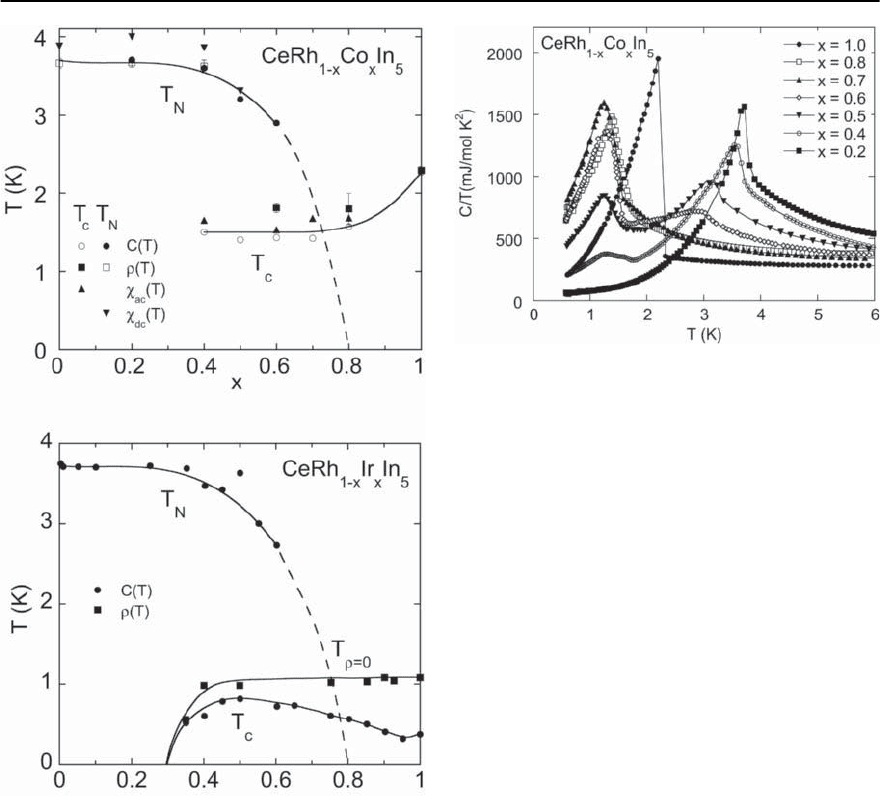
678 M.B. Maple et al.
Fig. 13.40. Phase diagrams of CeRh
1−x
Ir
x
In
5
and
CeRh
1−x
Co
x
In
5
.TheN´eel temperature T
N
, superconduct-
ing transition temperature T
c
, and the temperatures at
which the resistivity goes to zero T
=0
are shown vs Ir
or Co concentration x.Thelines are guides to the eye (af-
ter [191,261])
ing peaks are quite large, with C/ T
c
≈ 1formost
samples, and ∼ 5 for CeCoIn
5
,indicating that the su-
perconductivity is a bulk phenomenon involving the
heavy electrons.The magnitudeof the superconduct-
ing peaks is suppressed with decreasing x,whereas
the magnitude of the AFM peaks is enhanced with
decreasing x. The entropy at 7 K, which corresponds
Fig. 13.41. Specific heat C(T)shownasaplotofC/T vs
temperatureT for various CeRh
1−x
Co
x
In
5
compounds.The
peaks for T < 2 K are attributed to superconducting tran-
sitions, whereas the peaks for T > 3 K are ascribed to
antiferromagnetic phase transitions, after [191]
to the total area under the superconductingand AFM
peaks, is constant for the samples with x < 1, im-
plying that the same heavy electrons participate in
both the superconductivity and the antiferromag-
netism. The question arises whether the supercon-
ductivity and magnetism coexist on a microscopic
scale or if there are macroscopic concentration vari-
ations of Co and Rh within the sample.This question
has been investigated for the CeRh
1−x
Ir
x
In
5
system
by Morris and coworkers [263]. ‹SR measurements
in zero field of the CeRh
0.5
Ir
0.5
In
5
sample show that
the antiferromagnetism exists over at least 85% of
the sample, and ac magnetization measurements in-
dicate at least 85% shielding of the sample. Thus,
magnetism and superconductivity most likely coex-
istmicroscopicallyin thissample.Further discussion
of the CeRh
1−x
Ir
x
In
5
system can be found in the mul-
tiple superconducting phases section.
Noncentrosymmetric Superconductivity
It was thought for a long time that spin triplet su-
perconductivity can only occur if parity is satisfied
[264].In practice,this means that for heavy-fermion
superconductors the crystal structure must have in-
version symmetry (be centrosymmetric) since the
strong spin-orbit coupling in the HF compounds al-

13 Unconventional Superconductivity in Novel Materials 679
lows the electrons at the Fermi surface to see the
symmetry of the crystal. Most heavy-fermion super-
conductors to date have inversion symmetry. How-
ever, two HF superconductors were recently discov-
ered, CePt
3
Si [119] and UIr [168], whose crystal
structureslack inversion symmetry,and yetboth are
strong candidates for spin-triplet superconductiv-
ity.Other noncentrosymmetric pressure-induced su-
perconductors CeIrSi
3
[154], CeIrSi
3
[153], CeNiGe
3
[155], and Ce
2
Ni
3
Ge
5
[157], have also been recently
reported.
In UIr, ambient pressure ferromagnetism with
T
FM
= 46 K can be suppressed with 2.6 GPa of pres-
sure[167,168],leading to ferromagnetismcoexisting
with superconductivity against the background of
a noncentrosymmetric orthorhombic crystal struc-
ture below T
c
= 0.14 K [168].
CePt
3
Si orders antiferromagnetically below T
N
=
2.2 K andexhibits superconductivity below T
c
=0.75
K [119]. The crystalline lattice is shown in Fig.13.42.
In CePt
3
Si [119], the upper critical field H
c2
=4-5T
significantly exceeds the paramagnetic limit for sin-
glet superconductivity H
c2
∼ 1T.Thus,thereare
strong suggestions for spin triplet superconductivity
in both UIr and CePt
3
Si despite the lack of inver-
sion symmetry in the lattice structure. This apparent
coexistence of spin-triplet superconductivity with a
noncentrosymmetric symmetry challenges our un-
derstanding.
In general, Cooper pairs form between electrons
with equal and opposite momentum k.Broken inver-
sion symmetry splits the two spin-degenerate bands
forcing the electron with momentum k to pair with
an electron with momentum −k + Q, creating a fi-
nite momentum Cooper pair. It has been predicted
that this should result in a mixing of the spin sin-
glet andspin triplet branches [264].These arguments
were used to explain the lack of superconductivity in
the noncentrosymmetric compound MnSi, which is
a strong candidate for triplet superconductivity due
to the presence of a ferromagnetic quantum criti-
cal point [265]. If only pure triplet superconductiv-
ity cancoexist microscopically with ferromagnetism,
and the noncentrosymmetric symmetry prevents a
pure triplet superconductivity from forming,no su-
perconductivity should be observed at all.
Fig. 13.42. Tetragonal P4mm crystal structure of the heavy-
fermion superconductor CePt
3
Si, which does not have in-
version symmetry.Figure reproduced from [119].
A recent theoretical paper seeks to resolve the
issue of spin triplet superconductivity in noncen-
trosymmetric crystals. Frigeri et al. show that un-
der certain symmetry conditions that are satisfied
by CePt
3
Si, the paramagnetic limiting effect is sup-
pressed for both spin-singlet and spin-triplet super-
conductivity,and either type of superconducting or-
der parameter should be possible [265]. Another in-
triguing theory suggests thatthe paramagnetic limit-
ing fieldislifted in CePt
3
Si for fields along the tetrag-
onal a-axis through the formation of a helical vortex
phase [266].
Two other d-electron systems have been discov-
ered to our knowledge that exhibit superconductiv-
ity in a noncentrosymmetric crystalline lattice. In
the family R
2
C
3−y
(R = La,Y), there is no significant
spin-orbit coupling, so the symmetry of the lattice
does not necessarily affect the Cooper pairing wave
function.In the heavy-fermion compoundCd
2
Re
2
O
7
,
heavy-fermion superconductivity occurs in a non-
centrosymmetric lattice; however experimental evi-
dence points to nodeless s-wave superconductivity
and no magnetic order, thus there is no a priori
reason to assume spin triplet superconductivity (see
Sergienko et al. [267] and references therein).

680 M.B. Maple et al.
In UIr, the experimental conditions of high pres-
sure and millikelvin temperatures required to ob-
serve superconductivity have limited the number of
studiestodateonthiscompound.InCePt
3
Si how-
ever, a number of studies have already been com-
pleted since its recent discovery.We will therefore re-
view some keyexperimental findings here that probe
the question of spin singlet or spin triplet supercon-
ductivity surviving in the absence of parity.
Theexperimentalevidencetodateprovidescon-
flicting evidencefor the natureofthepairingsymme-
try in CePt
3
Si. The Sommerfeld coefficient = 390
mJ/mol K
2
results in a value of C/ T
c
= 0.25-0.55
that is much lower than the BCS weak coupling pre-
diction of 1.43.A similar depressed value of C/ T
c
has been observed in the spin-triplet superconduc-
tor SrRu
2
O
4
. However, the low value may also indi-
cate that the Fermi surface is divided between super-
conductivity and antiferromagnetism. Substitution
studies of La on the Ce site show a strong suppres-
sion of superconductivity with only 2% La, which
supports a spin-triplet scenario [268].
Neutron scattering results [269] have shown an
ordered moment on the Ce atom of 0.16
B
/Ce atom
in the AFM phase, which is strongly reduced from
the Hund’s rule prediction.This most likely indicates
itinerant antiferromagnetism. On the other hand,
well-defined CEF behavior in magnetization and
NMR measurements indicates at least a partial local-
ization of Ce spins[180,269].The Ce momentsareor-
dered ferromagnetically in the basal plane and stack
antiferromagnetically along the c-axis[269].SR ex-
periments show that magnetism occurs in the whole
sample volume, indicating microscopic coexistence
of superconductivity and antiferromagnetism [270].
NMR measurements [269] indicate that CePt
3
Si is
the first heavy-fermion superconductor to exhibit a
Hebel-Slichter peak in 1/T
1
T below T
c
.CePt
3
Si does
not show the 1/T
1
∝ T
3
behavior that is observed
in most other HF superconductors, and the behav-
ior indicates point-nodesin the superconductinggap
function that would be consistent with a spin-triplet
pairing wave function. On the other hand, thermal
transport and magnetic penetration [271,272] ex-
periments show power-law behavior at low temper-
atures indicating line nodes in the superconduct-
ing gap. Recent theoretical work proposes that line
nodes are possible even in the absence of parity in
CePt
3
Si [267,273,274].The nature ofthe pairing sym-
metry and its interaction with the crystal lattice sym-
metryremainopenquestionsinCePt
3
Si and we look
forward to many future studies probing this interest-
ing compound.
13.3.6 Non-Fermi Liquid Behavior
At the time of their discovery, nearly all of
the heavy-fermion superconductors were found to
have Fermi liquid properties, i.e., (T) ∝ T
2
and
C(T)/T ∝ (T) ∝ constant. However, unusual tem-
perature dependences of the physical properties,
such as a linear T-dependence of the electrical re-
sistivity [275], known as non-Fermi liquid behavior,
have been observed in many heavy-Fermion com-
pound since their first observation in UBe
13
.Inpar-
ticular, the relatively weak magnetic field depen-
dence of the electrical resistivity and specific heat,
and the absence of a quasi-elastic peak in neutron
scattering measurements in UBe
13
do not follow the
expected behavior of a conventional Kondo effect,
which is thought to be the origin of the heavy-
fermion characteristics. These experimental data led
Cox to propose a two channel quadrupolar Kondo
model, in which the interaction between the electric
quadrupole moments of a U
4+
nonmagnetic doublet
ground state in a cubic crystalline electric field and
the charges of the conduction electrons give rise to
NFL behavior at low temperatures [276,277].
A fewyearslater,NFLbehavior wasobserved [278]
in the Y
1−x
U
x
Pd
3
system over a wide range of U con-
centrations x in the paramagnetic phase below the
critical concentration x
cr
=0.2 where the magnetic
transition temperature (later identified as the spin
glass freezing temperature [279,280])vanished. This
discovery started a period of intense research in f -
electron materials in order to further investigate the
occurrence and origin of non-Fermi liquid behavior
[281–284]. Non-Fermi liquid behavior in f -electron
systems is characterized by weak power-law or log-
arithmic temperature dependences of the physical
properties at low temperatures T T
0
for most f -
electron systems and can be summarized as follows:
